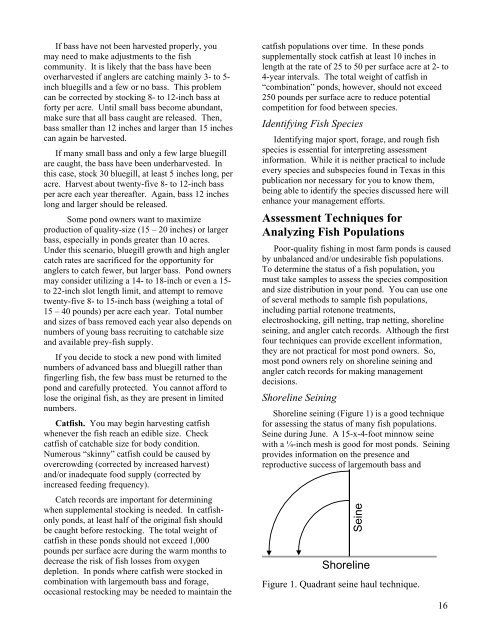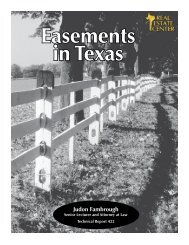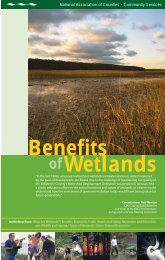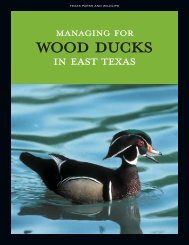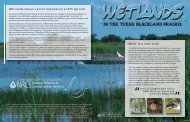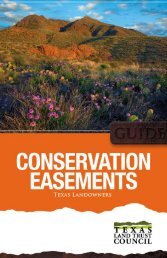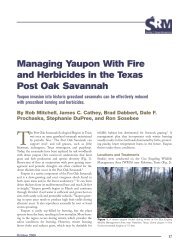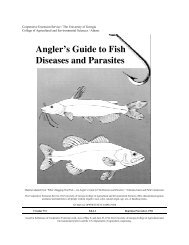Texas Farm Ponds: Stocking, Assessment, and Management ...
Texas Farm Ponds: Stocking, Assessment, and Management ...
Texas Farm Ponds: Stocking, Assessment, and Management ...
Create successful ePaper yourself
Turn your PDF publications into a flip-book with our unique Google optimized e-Paper software.
If bass have not been harvested properly, you<br />
may need to make adjustments to the fish<br />
community. It is likely that the bass have been<br />
overharvested if anglers are catching mainly 3- to 5-<br />
inch bluegills <strong>and</strong> a few or no bass. This problem<br />
can be corrected by stocking 8- to 12-inch bass at<br />
forty per acre. Until small bass become abundant,<br />
make sure that all bass caught are released. Then,<br />
bass smaller than 12 inches <strong>and</strong> larger than 15 inches<br />
can again be harvested.<br />
If many small bass <strong>and</strong> only a few large bluegill<br />
are caught, the bass have been underharvested. In<br />
this case, stock 30 bluegill, at least 5 inches long, per<br />
acre. Harvest about twenty-five 8- to 12-inch bass<br />
per acre each year thereafter. Again, bass 12 inches<br />
long <strong>and</strong> larger should be released.<br />
Some pond owners want to maximize<br />
production of quality-size (15 – 20 inches) or larger<br />
bass, especially in ponds greater than 10 acres.<br />
Under this scenario, bluegill growth <strong>and</strong> high angler<br />
catch rates are sacrificed for the opportunity for<br />
anglers to catch fewer, but larger bass. Pond owners<br />
may consider utilizing a 14- to 18-inch or even a 15-<br />
to 22-inch slot length limit, <strong>and</strong> attempt to remove<br />
twenty-five 8- to 15-inch bass (weighing a total of<br />
15 – 40 pounds) per acre each year. Total number<br />
<strong>and</strong> sizes of bass removed each year also depends on<br />
numbers of young bass recruiting to catchable size<br />
<strong>and</strong> available prey-fish supply.<br />
If you decide to stock a new pond with limited<br />
numbers of advanced bass <strong>and</strong> bluegill rather than<br />
fingerling fish, the few bass must be returned to the<br />
pond <strong>and</strong> carefully protected. You cannot afford to<br />
lose the original fish, as they are present in limited<br />
numbers.<br />
Catfish. You may begin harvesting catfish<br />
whenever the fish reach an edible size. Check<br />
catfish of catchable size for body condition.<br />
Numerous “skinny” catfish could be caused by<br />
overcrowding (corrected by increased harvest)<br />
<strong>and</strong>/or inadequate food supply (corrected by<br />
increased feeding frequency).<br />
Catch records are important for determining<br />
when supplemental stocking is needed. In catfishonly<br />
ponds, at least half of the original fish should<br />
be caught before restocking. The total weight of<br />
catfish in these ponds should not exceed 1,000<br />
pounds per surface acre during the warm months to<br />
decrease the risk of fish losses from oxygen<br />
depletion. In ponds where catfish were stocked in<br />
combination with largemouth bass <strong>and</strong> forage,<br />
occasional restocking may be needed to maintain the<br />
catfish populations over time. In these ponds<br />
supplementally stock catfish at least 10 inches in<br />
length at the rate of 25 to 50 per surface acre at 2- to<br />
4-year intervals. The total weight of catfish in<br />
“combination” ponds, however, should not exceed<br />
250 pounds per surface acre to reduce potential<br />
competition for food between species.<br />
Identifying Fish Species<br />
Identifying major sport, forage, <strong>and</strong> rough fish<br />
species is essential for interpreting assessment<br />
information. While it is neither practical to include<br />
every species <strong>and</strong> subspecies found in <strong>Texas</strong> in this<br />
publication nor necessary for you to know them,<br />
being able to identify the species discussed here will<br />
enhance your management efforts.<br />
<strong>Assessment</strong> Techniques for<br />
Analyzing Fish Populations<br />
Poor-quality fishing in most farm ponds is caused<br />
by unbalanced <strong>and</strong>/or undesirable fish populations.<br />
To determine the status of a fish population, you<br />
must take samples to assess the species composition<br />
<strong>and</strong> size distribution in your pond. You can use one<br />
of several methods to sample fish populations,<br />
including partial rotenone treatments,<br />
electroshocking, gill netting, trap netting, shoreline<br />
seining, <strong>and</strong> angler catch records. Although the first<br />
four techniques can provide excellent information,<br />
they are not practical for most pond owners. So,<br />
most pond owners rely on shoreline seining <strong>and</strong><br />
angler catch records for making management<br />
decisions.<br />
Shoreline Seining<br />
Shoreline seining (Figure 1) is a good technique<br />
for assessing the status of many fish populations.<br />
Seine during June. A 15-x-4-foot minnow seine<br />
with a ¼-inch mesh is good for most ponds. Seining<br />
provides information on the presence <strong>and</strong><br />
reproductive success of largemouth bass <strong>and</strong><br />
Seine<br />
Shoreline<br />
Figure 1. Quadrant seine haul technique.<br />
16


